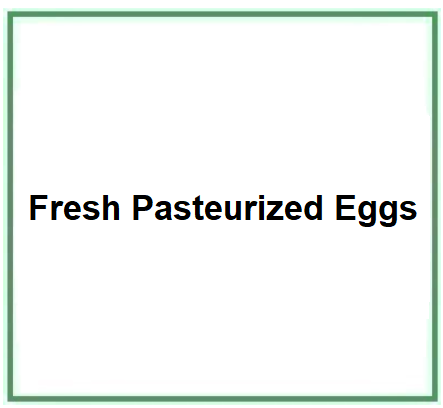Fresh Pasteurized Eggs is a food product that has been subjected to a pasteurization process to eliminate harmful microorganisms while keeping the eggs fresh.
Raw materials used in production.
- Eggs, usually from chickens, are the main raw material. The eggs are collected fresh and then subjected to the pasteurization process.
Step-by-step summary of industrial production process.
- Collection. Eggs are collected from chickens raised under various conditions, depending on local practices and regulations.
- Cleaning. The eggs are cleaned to remove any dirt or debris present on the shell.
- Pasteurization. The eggs are heated to a specific temperature for a set period of time to kill bacteria, such as Salmonella, without cooking the egg.
- Cooling. The eggs are rapidly cooled to halt the cooking process and preserve freshness.
Form and color.
Fresh pasteurized eggs may be available both in liquid form and packaged and retain the natural color of the egg, with the white and yolk distinctly visible unless they have been mixed together.
Commercial applications.
Used in cooking, baking, and in the food industry where food safety is paramount, and the use of raw eggs is risky or not recommended.
Food Use. Fresh pasteurized eggs are used in a variety of recipes, including desserts, sauces, and dishes requiring raw or semi-cooked eggs, to reduce the risk of salmonella and other pathogens.
Bakery and Confectionery Products. They are used in baking and other food preparations where food safety and consistency are crucial, such as in meringues or custards.
Catering. In catering and large kitchens, pasteurized eggs are preferred for their food safety and ease of use.
Home Cooking. They are also utilized in home cooking for recipes requiring raw eggs, like homemade mayonnaise, providing a safer option than raw eggs.
Doubts focus on the cholesterol content and its potential role in cardio-metabolic outcomes.
A whole or boiled chicken egg contains about 15 micrograms of selenium and in addition iron, Vitamin B2, B12, D, E
It also contains lutein, a carotenoid that can be protective against diseases such as age-related macular degeneration (1) and choline, a cellular and nervous restructurer and anti-inflammatory.(2)
Recent studies have also shown that the egg, due to its vitamin D content, helps protect the eyes from cataracts and other degenerative diseases due to ageing.
On the other hand, health recommendations indicate that dietary cholesterol should be limited to less than 200 mg per day; a single large egg yolk contains about 275 mg of cholesterol (3), so taking even a single egg increases LDL cholesterol.

The consumption of whole egg in the middle-aged and elderly population has long been discussed in the scientific literature. The impact on the cardiovascular system with possibility of disease has been under observation for several years. However, this study considers that the intake of whole egg does not affect the risk of cardiovascular disease (4).
This study, on the other hand, considers that a high consumption of eggs is significantly associated with a higher risk of contracting incidental cardiovascular diseases (5).
Egg studies
References____________________________________________________________
(1) Chung HY, Rasmussen HM, Johnson EJ. Lutein bioavailability is higher from lutein-enriched eggs than from supplements and spinach in men. J Nutr. 2004 Aug;134(8):1887-93. 2004.
(2) Zeisel SH. Choline: critical role during fetal development and dietary requirements in adults. Annu Rev Nutr. 2006;26:229-50. 2006.
(3) Dietary cholesterol and egg yolks: not for patients at risk of vascular disease. Spence JD, Jenkins DJ, Davignon J. Can J Cardiol. 2010 Nov;26(9):e336-9.
(4) Impact of whole egg intake on blood pressure, lipids and lipoproteins in middle-aged and older population: A systematic review and meta-analysis of randomized controlled trials. Wang MX, Wong CH, Kim JE. Nutr Metab Cardiovasc Dis. 2019 Jul;29(7):653-664. doi: 10.1016/j.numecd.2019.04.004.
(5) Associations of Dietary Cholesterol or Egg Consumption With Incident Cardiovascular Disease and Mortality. Zhong VW, Van Horn L, Cornelis MC, Wilkins JT, Ning H, Carnethon MR, Greenland P, Mentz RJ, Tucker KL, Zhao L, Norwood AF, Lloyd-Jones DM, Allen NB. JAMA. 2019 Mar 19;321(11):1081-1095. doi: 10.1001/jama.2019.1572.
![]() Fresh Pasteurized Eggs
Fresh Pasteurized Eggs 


